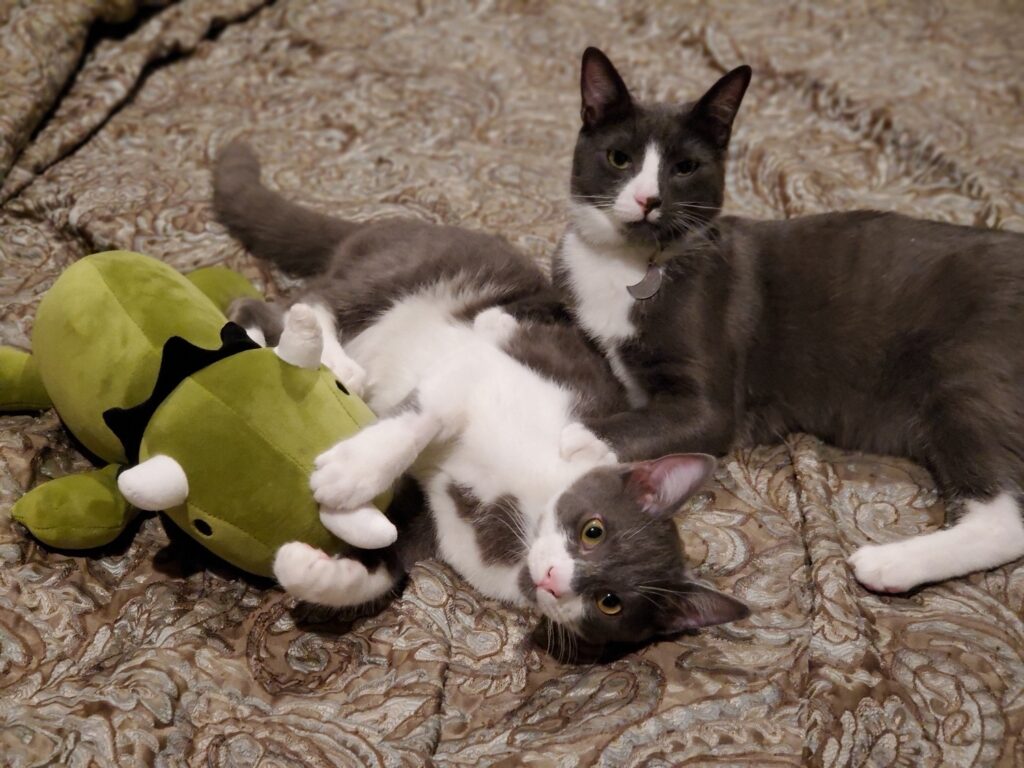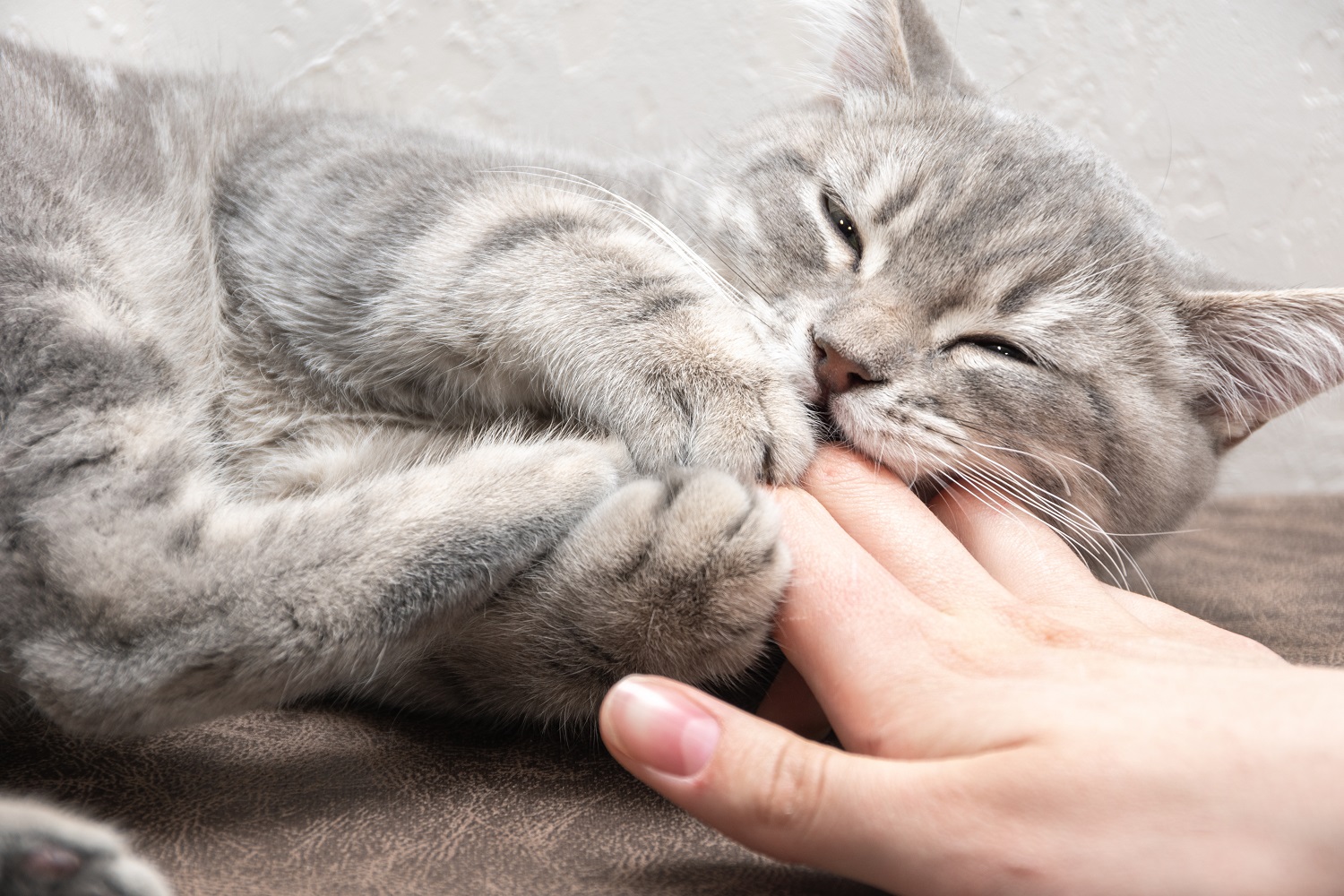You are petting your cat, minding your own business, when suddenly they grab your arm with their front paws, wrap their back legs around it, and start kicking like they are training for the feline UFC. Surprise! You have been bunny kicked.
Bunny kicking is a natural feline behavior, and while it might catch you off guard, it is not always a sign of aggression. In fact, it is often playful or instinctual, depending on the moment.
Let’s take a closer look at what bunny kicking really means, why your cat does it to you, and how to tell if it is a game or a warning.
What Is Bunny Kicking and Why Do Cats Do It?
Bunny kicking is when a cat wraps its front legs around an object and delivers quick, repetitive kicks with its back feet. It is named after the way rabbits kick with their hind legs, but in cats, it serves a very different purpose.
In the wild, cats use this move to hold and disarm prey, often during a hunt or fight. It is both defensive and offensive. The front paws hold the target close, and the back legs deliver powerful blows that can quickly incapacitate a small animal.
While your cat is not hunting your arm for dinner, those same instincts are still at play. Whether it is playtime, overstimulation, or a bit of pent-up energy, that bunny kick is your cat’s way of expressing themselves through a move they have perfected over thousands of years.
Reasons Your Cat Grabs and Bunny Kicks Your Arm
Not all bunny kicks are created equal. Some are full of love. Others are full of sass. Understanding the motivation behind your cat’s behavior helps you respond appropriately and avoid any accidental scratches.
1. Playful behavior
When cats get excited during play, especially with soft toys or hands that move too much, they may grab and kick. It is a high-energy move that feels satisfying and fun. If the claws stay retracted and your cat seems engaged rather than agitated, it is probably just part of their play style.
2. Hunting instinct
Even indoor cats have strong hunting instincts. If your hand moves quickly or dangles like prey, your cat may grab and kick as if they are taking down a mouse. It is not personal. It is just their brain saying, “Catch it now!”
3. Overstimulation
Sometimes, petting sessions can go from sweet to spicy in seconds. If your cat becomes overstimulated, they might grab your arm and kick as a signal that they are done being touched. This can happen quickly and may come with flattened ears or a flicking tail.
4. Defensive reaction
If your cat feels startled or trapped, the bunny kick can be a defensive move. It is their way of creating distance while staying in control. This version is more intense and usually comes with claws and teeth.
5. Communication and boundaries
Cats do not always use words to say, “That is enough.” Sometimes they use their feet. If your cat bunny kicks after a long cuddle or if they do it gently and then walk away, they may be telling you they need space.
How to Tell If It Is Playful or Aggressive
The key to interpreting the bunny kick lies in your cat’s body language and energy.
Playful bunny kicks:
- Soft or retracted claws
- Relaxed ears and body
- No growling or hissing
- Will often return to play right after
- Purring or chirping may still happen
Defensive or aggressive bunny kicks:
- Extended claws and biting
- Stiff body or flicking tail
- Ears flattened against the head
- Hissing, growling, or sudden running away
- Attempting to escape or hide afterward
If you notice signs of agitation, give your cat some space. Respecting their limits helps build trust and prevents unwanted scratches.

Today, I decided to teach my little furball brother Joey the art of the bunny-kick. As the experienced ninja master that I am, I couldn’t let him continue flailing around like a clumsy oaf. He really is, you know… We started with the basics. He was adorably clumsy at first, but with my expert guidance, he started to get the hang of it. Of course, I couldn’t resist rubbing his nose in it every time he messed up. After all, what are big brothers for? By the end of our session, he was bunny kicking like a pro. Well, sort of. #BunnyKickMasterclass #NinjaKitty #BunnyKickMaster #FurSiblingsInTraining #BigBrotherDuties
Sensai Winston with his pupil, Joey
How to Handle Bunny Kicking Without Getting Hurt
If your cat bunny kicks during play and you are fine with it, great. But if it becomes too rough or starts during cuddle sessions, there are ways to redirect the behavior.
Use toys instead of hands
Keep wand toys, kickers, or plush mice on hand during play. Encourage your cat to grab and kick those instead of your limbs.
Watch for overstimulation cues
Learn your cat’s tolerance levels. Some cats love a long belly rub. Others will allow five pets and then retaliate with a kick. Pay attention to their signals and stop before they hit their limit.
Redirect the energy
If your cat starts to grab your arm, gently move them away and offer a toy instead. Praise them when they engage with the toy to reinforce the behavior you want.
Do not punish or yell
Reacting harshly can make your cat fearful or defensive. Stay calm and focus on redirecting, not scolding.
Should You Be Concerned?
In most cases, bunny kicking is completely normal and not a cause for concern. It is part of how cats explore, express, and interact.
You may want to consult your vet or a behaviorist if:
- The kicking is aggressive and frequent
- Your cat seems easily triggered or fearful
- The behavior happens during routine touch or calm interactions
- You cannot handle your cat without being scratched
Sudden changes in behavior can be a sign of pain, stress, or discomfort, so if the bunny kicking seems out of character, a professional checkup is a good idea.
Final Thoughts: Bunny Kicks Are a Mix of Instinct, Energy, and Attitude
When your cat grabs your arm and bunny kicks, they are not turning on you. They are showing off one of their most primal moves, sometimes for fun and sometimes as a gentle warning. Understanding the motivation behind it helps you stay in sync with your cat and avoid confusion or frustration.
So next time your cat wraps their paws around your arm and delivers a round of swift kicks, remember they are not trying to ruin your day. They are just being a cat. A very athletic, opinionated, and occasionally dramatic one.
Sources:
Why Do Cats Bunny Kick? https://www.petmd.com/cat/behavior/why-do-cats-bunny-kick
Feline Play and Aggression https://www.icatcare.org/advice/playing-with-your-cat
Understanding Cat Body Language https://www.humanesociety.org/resources/understanding-your-cats-behavior
Cat Communication Signals https://vcahospitals.com/know-your-pet/behavior-cats-normal-vs-abnormal
Recent Posts
Your Cat Might Be a Furry Little Healer… or at Least a Fuzzy Alarm System If you’ve ever had your cat suddenly become extra clingy when you’re under the weather, you’re not alone. From...
Cats are experts at hiding things, socks under furniture, their disdain for your playlist, and, unfortunately, symptoms of illness. In the wild, showing weakness could make them a target, so even...


